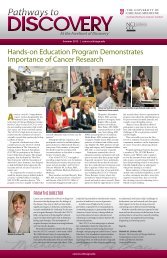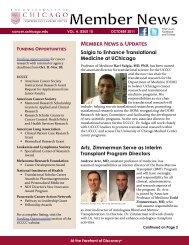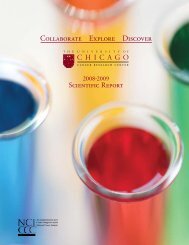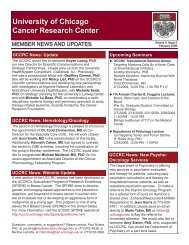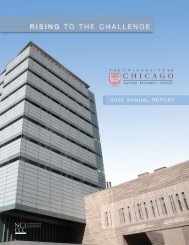ANNUAL REPORT 2003-2004 L REPORT Cancer Cures On All Fronts
ANNUAL REPORT 2003-2004 L REPORT Cancer Cures On All Fronts
ANNUAL REPORT 2003-2004 L REPORT Cancer Cures On All Fronts
Create successful ePaper yourself
Turn your PDF publications into a flip-book with our unique Google optimized e-Paper software.
<strong>Cancer</strong> <strong>Cures</strong> In the Clinic<br />
Nobel Laureate and Ben May Institute for <strong>Cancer</strong> Research founder Charles B. Huggins, MD, affirmed<br />
a simple message to his students: the battle against cancer begins with discoveries that illuminate<br />
why organisms thrive and why they fail. Thus, cancer cures begin in fundamental research that<br />
launches clinical research and culminates in superior cancer care. Whether in the lab or the clinic, our scientists<br />
and clinicians share a common goal: to transform discovery into therapy.<br />
Consequently, our researchers often have one foot in the lab and one in the clinic. Like Dr. Huggins, they<br />
recognize the usefulness of collaborative research that involves scientists and clinicians. As a result, no clear,<br />
bright line separates the lab from the clinic.<br />
Bringing Advanced Therapies to Patients<br />
Ben May Institute for <strong>Cancer</strong> Research investigator Thomas F. Gajewski, MD, PhD, and his team, for<br />
example, explore ways to control, manipulate and enhance immune responses against cancer. Their<br />
findings enable them to develop vaccines and other immune therapies that they first test in mice<br />
bearing established tumors. Approaches that reduce tumors in animals become candidates for human<br />
testing. Dr. Gajewski and his team have already shown tumor shrinkage in patients with a vaccine<br />
against melanoma. They have new vaccines that are being investigated in patients with pancreatic<br />
and kidney cancers. This work relies on the collaboration of basic immunology researchers, medical<br />
oncologists, surgeons, and pathologists.<br />
Clinical trials provide the means for bringing the benefits of their advanced research directly to the<br />
patients who most need them. More than 1,000 patients participate annually in our clinical trials<br />
program, which is one of most comprehensive and sophisticated in the world. We are one of only a<br />
handful of institutions with the expertise, resources and capabilities to take oversight responsibility for<br />
trials representing all three phases of clinical research. This three-phase process allows for the orderly<br />
gathering of information, ensures patient safety, and maximizes therapeutic value.<br />
A Three-Phase Process<br />
Phase I studies involve the fewest number of patients. Their purpose is to determine how to administer<br />
new drugs and what are the safest, most effective doses. Phase II trials continue to focus on safety and<br />
begin the analysis of the effectiveness of innovative therapies. Phase III trials usually enroll numerous<br />
patients and involve numerous institutions under the direction of a lead research center. These trials<br />
compare experimental drugs, combinations of drugs or surgical procedures with existing therapies to<br />
determine if innovations are superior to the current standards.<br />
Seeking <strong>Cancer</strong> <strong>Cures</strong> <strong>On</strong> <strong>All</strong> <strong>Fronts</strong> | | UCCRC Annual Report <strong>2003</strong>-<strong>2004</strong><br />
9





